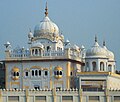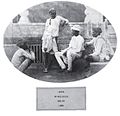|
The Punjab Portal Introduction Punjab ( /pʌnˈdʒɑːb, -ˈdʒæb, ˈpʊn-/; Punjabi: [pə̞ɲˈdʒäːb] ; also romanised as Panjāb or Panj-Āb), also known as the Land of the Five Rivers, is a geopolitical, cultural, and historical region in South Asia. It is specifically located in the northwestern part of the Indian subcontinent, comprising areas of modern-day eastern- Pakistan and northwestern- India. Punjab's major cities are Lahore, Faisalabad, Rawalpindi, Gujranwala, Multan, Ludhiana, Amritsar, Sialkot, Chandigarh, Shimla, Jalandhar, Patiala, Gurugram, and Bahawalpur. Punjab grew out of the settlements along the five rivers, which served as an important route to the Near East as early as the ancient Indus Valley civilization, dating back to 3000 BCE, followed by migrations of the Indo-Aryan peoples. Agriculture has been the major economic feature of the Punjab and has therefore formed the foundation of Punjabi culture. The Punjab emerged as an important agricultural region, especially following the Green Revolution during the mid-1960s to the mid-1970s, and has been described as the "breadbasket of both India and Pakistan." Punjab's history is a tapestry of conflict, marked by the rise of indigenous dynasties and empires. Following Alexander the Great's invasion in the 4th century BCE, Chandragupta Maurya allied with Punjabi republics to establish the Maurya Empire. Successive reigns of the Indo-Greek Kingdom, Kushan Empire, and Indo-Scythians followed, but were ultimately defeated by Eastern Punjab Janapadas such as the Yaudheya, Trigarta Kingdom, Audumbaras, Arjunayanas, and Kuninda Kingdom. In the 5th and 6th centuries CE, Punjab faced devastating Hunnic invasions, yet the Vardhana dynasty emerged triumphant, ruling over Northern India. The 8th century CE witnessed the Hindu Shahis rise, known for defeating the Saffarid dynasty and the Samanid Empire. Concurrently, the Tomara dynasty and Katoch Dynasty controlled eastern Punjab, resisting Ghaznavid invasions. Islam took hold in Western Punjab under Ghaznavid rule. The Delhi Sultanate then succeeded the Ghaznavids in which the Tughlaq dynasty and Sayyid dynasty Sultans are described as Punjabi origin. The 15th century saw the emergence of the Langah Sultanate in south Punjab, acclaimed for its victory over the Lodi dynasty. After the Mughal Empire's decline in the 18th century, Punjab experienced a period of anarchy. In 1799 CE, the Sikh Empire established its rule, undertaking conquests into Kashmir and Durrani Empire held territories, shaping the diverse and complex history of Punjab. The boundaries of the region are ill-defined and focus on historical accounts and thus the geographical definition of the term "Punjab" has changed over time. In the 16th century Mughal Empire the Punjab region was divided into three, with the Lahore Subah in the west, the Delhi Subah in the east and the Multan Subah in the south. In British India, until the Partition of India in 1947, the Punjab Province encompassed the present-day Indian states and union territories of Punjab, Haryana, Himachal Pradesh, Chandigarh, and Delhi, and the Pakistani regions of Punjab, and Islamabad Capital Territory. The predominant ethnolinguistic group of the Punjab region are the Punjabi people, who speak the Indo-Aryan Punjabi language. Punjabi Muslims are the majority in West Punjab (Pakistan), while Punjabi Sikhs are the majority in East Punjab (India). Other religious groups include Hinduism, Christianity, Jainism, Zoroastrianism, Buddhism, and Ravidassia. ( Full article...) Selected article -
Sri Guru Ram Das Ji International Airport (
IATA: ATQ,
ICAO: VIAR) is an
international airport serving
Amritsar,
Punjab,
India. It is located at
Raja Sansi, 11 km (7 mi) north-west from the city centre. It is named after
Guru Ram Das, the fourth
Sikh Guru and the founder of Amritsar. The airport is the largest and the busiest airport of Punjab. It is the third-largest airport in
Northern India after
Indira Gandhi International Airport in
Delhi. The airport was the 3rd fastest-growing airport in India during the fiscal year 2017–18. It is a hub of cargo movements, domestically and internationally. The airport is ranked the 6th-best regional airport in
India and
Central Asia in 2019 and 2020 by
Skytrax. The airport is awarded as the best airport in
Asia-Pacific in 2020 (2 to 5 million passengers per annum) by
Airports Council International. The airport also featured in the top 10 airports in India and South Asia with Best Airport Staff for the year 2024 by
Skytrax. (
Full article...)
General imagesSelected biography -Princess Sophia Alexandrovna Duleep Singh (8 August 1876 – 22 August 1948) was a prominent suffragette in the United Kingdom. Her father was Maharaja Sir Duleep Singh, who had lost his Sikh Empire to the Punjab Province of British India and was subsequently exiled to England. Sophia's mother was Bamba Müller, who was half German and half Ethiopian, and her godmother was Queen Victoria. She had four sisters, including two half-sisters, and three brothers. She lived at Hampton Court Palace in an apartment in Faraday House given to her by Queen Victoria as a grace-and-favour home. During the early twentieth century, Singh was one of several Indian women who pioneered the cause of women's rights in Britain. Although she is best remembered for her leading role in the Women's Tax Resistance League, she also participated in other women's suffrage groups, including the Women's Social and Political Union. ( Full article...)Selected picture -Some topicsCategoriesSelect [►] to view subcategories
Select [►] to view subcategories
1799-1849 definition: Chandigarh - Delhi - Eastern Punjab state - Federally Administered Tribal Areas - Galgit - Haryana - Himachal Pradesh - Islamabad Capital Territory - Jammu - Kashmir - Khyber Pass - Khyber Pakhtunkhwa - Ladakh - Western Punjab province 1947 definition: Chandigarh - Delhi - Eastern Punjab state - Haryana - Himachal Pradesh - Islamabad Capital Territory - Western Punjab province Present definition: Chandigarh - Eastern Punjab state - Western Punjab province Major cities: Amritsar - Bathinda - Chandigarh - Faisalabad - Lahore - Ludhiana - Multan - Patiala - Sialkot WikiProject PunjabWikiProject Punjab was formed to foster better articles on the region of Punjab with a spirit of cooperation. The project is a home base that provides a place for Wikipedians (editors) to discuss issues, while share information and resources regarding improvements to Punjabi related articles, which can be discussed at the project's talk page. To join WikiProject Punjab (anyone may join), simply list your username on the members page. Editors are also encouraged to participate in the more regional and/or topic specific WikiProject 's as listed below. Associated WikimediaThe following Wikimedia Foundation sister projects provide more on this subject:
Wikipedia in Punjabi
Discover Wikipedia using
portals |
|
The Punjab Portal Introduction Punjab ( /pʌnˈdʒɑːb, -ˈdʒæb, ˈpʊn-/; Punjabi: [pə̞ɲˈdʒäːb] ; also romanised as Panjāb or Panj-Āb), also known as the Land of the Five Rivers, is a geopolitical, cultural, and historical region in South Asia. It is specifically located in the northwestern part of the Indian subcontinent, comprising areas of modern-day eastern- Pakistan and northwestern- India. Punjab's major cities are Lahore, Faisalabad, Rawalpindi, Gujranwala, Multan, Ludhiana, Amritsar, Sialkot, Chandigarh, Shimla, Jalandhar, Patiala, Gurugram, and Bahawalpur. Punjab grew out of the settlements along the five rivers, which served as an important route to the Near East as early as the ancient Indus Valley civilization, dating back to 3000 BCE, followed by migrations of the Indo-Aryan peoples. Agriculture has been the major economic feature of the Punjab and has therefore formed the foundation of Punjabi culture. The Punjab emerged as an important agricultural region, especially following the Green Revolution during the mid-1960s to the mid-1970s, and has been described as the "breadbasket of both India and Pakistan." Punjab's history is a tapestry of conflict, marked by the rise of indigenous dynasties and empires. Following Alexander the Great's invasion in the 4th century BCE, Chandragupta Maurya allied with Punjabi republics to establish the Maurya Empire. Successive reigns of the Indo-Greek Kingdom, Kushan Empire, and Indo-Scythians followed, but were ultimately defeated by Eastern Punjab Janapadas such as the Yaudheya, Trigarta Kingdom, Audumbaras, Arjunayanas, and Kuninda Kingdom. In the 5th and 6th centuries CE, Punjab faced devastating Hunnic invasions, yet the Vardhana dynasty emerged triumphant, ruling over Northern India. The 8th century CE witnessed the Hindu Shahis rise, known for defeating the Saffarid dynasty and the Samanid Empire. Concurrently, the Tomara dynasty and Katoch Dynasty controlled eastern Punjab, resisting Ghaznavid invasions. Islam took hold in Western Punjab under Ghaznavid rule. The Delhi Sultanate then succeeded the Ghaznavids in which the Tughlaq dynasty and Sayyid dynasty Sultans are described as Punjabi origin. The 15th century saw the emergence of the Langah Sultanate in south Punjab, acclaimed for its victory over the Lodi dynasty. After the Mughal Empire's decline in the 18th century, Punjab experienced a period of anarchy. In 1799 CE, the Sikh Empire established its rule, undertaking conquests into Kashmir and Durrani Empire held territories, shaping the diverse and complex history of Punjab. The boundaries of the region are ill-defined and focus on historical accounts and thus the geographical definition of the term "Punjab" has changed over time. In the 16th century Mughal Empire the Punjab region was divided into three, with the Lahore Subah in the west, the Delhi Subah in the east and the Multan Subah in the south. In British India, until the Partition of India in 1947, the Punjab Province encompassed the present-day Indian states and union territories of Punjab, Haryana, Himachal Pradesh, Chandigarh, and Delhi, and the Pakistani regions of Punjab, and Islamabad Capital Territory. The predominant ethnolinguistic group of the Punjab region are the Punjabi people, who speak the Indo-Aryan Punjabi language. Punjabi Muslims are the majority in West Punjab (Pakistan), while Punjabi Sikhs are the majority in East Punjab (India). Other religious groups include Hinduism, Christianity, Jainism, Zoroastrianism, Buddhism, and Ravidassia. ( Full article...) Selected article -
Sri Guru Ram Das Ji International Airport (
IATA: ATQ,
ICAO: VIAR) is an
international airport serving
Amritsar,
Punjab,
India. It is located at
Raja Sansi, 11 km (7 mi) north-west from the city centre. It is named after
Guru Ram Das, the fourth
Sikh Guru and the founder of Amritsar. The airport is the largest and the busiest airport of Punjab. It is the third-largest airport in
Northern India after
Indira Gandhi International Airport in
Delhi. The airport was the 3rd fastest-growing airport in India during the fiscal year 2017–18. It is a hub of cargo movements, domestically and internationally. The airport is ranked the 6th-best regional airport in
India and
Central Asia in 2019 and 2020 by
Skytrax. The airport is awarded as the best airport in
Asia-Pacific in 2020 (2 to 5 million passengers per annum) by
Airports Council International. The airport also featured in the top 10 airports in India and South Asia with Best Airport Staff for the year 2024 by
Skytrax. (
Full article...)
General imagesSelected biography -Princess Sophia Alexandrovna Duleep Singh (8 August 1876 – 22 August 1948) was a prominent suffragette in the United Kingdom. Her father was Maharaja Sir Duleep Singh, who had lost his Sikh Empire to the Punjab Province of British India and was subsequently exiled to England. Sophia's mother was Bamba Müller, who was half German and half Ethiopian, and her godmother was Queen Victoria. She had four sisters, including two half-sisters, and three brothers. She lived at Hampton Court Palace in an apartment in Faraday House given to her by Queen Victoria as a grace-and-favour home. During the early twentieth century, Singh was one of several Indian women who pioneered the cause of women's rights in Britain. Although she is best remembered for her leading role in the Women's Tax Resistance League, she also participated in other women's suffrage groups, including the Women's Social and Political Union. ( Full article...)Selected picture -Some topicsCategoriesSelect [►] to view subcategories
Select [►] to view subcategories
1799-1849 definition: Chandigarh - Delhi - Eastern Punjab state - Federally Administered Tribal Areas - Galgit - Haryana - Himachal Pradesh - Islamabad Capital Territory - Jammu - Kashmir - Khyber Pass - Khyber Pakhtunkhwa - Ladakh - Western Punjab province 1947 definition: Chandigarh - Delhi - Eastern Punjab state - Haryana - Himachal Pradesh - Islamabad Capital Territory - Western Punjab province Present definition: Chandigarh - Eastern Punjab state - Western Punjab province Major cities: Amritsar - Bathinda - Chandigarh - Faisalabad - Lahore - Ludhiana - Multan - Patiala - Sialkot WikiProject PunjabWikiProject Punjab was formed to foster better articles on the region of Punjab with a spirit of cooperation. The project is a home base that provides a place for Wikipedians (editors) to discuss issues, while share information and resources regarding improvements to Punjabi related articles, which can be discussed at the project's talk page. To join WikiProject Punjab (anyone may join), simply list your username on the members page. Editors are also encouraged to participate in the more regional and/or topic specific WikiProject 's as listed below. Associated WikimediaThe following Wikimedia Foundation sister projects provide more on this subject:
Wikipedia in Punjabi
Discover Wikipedia using
portals |



























































